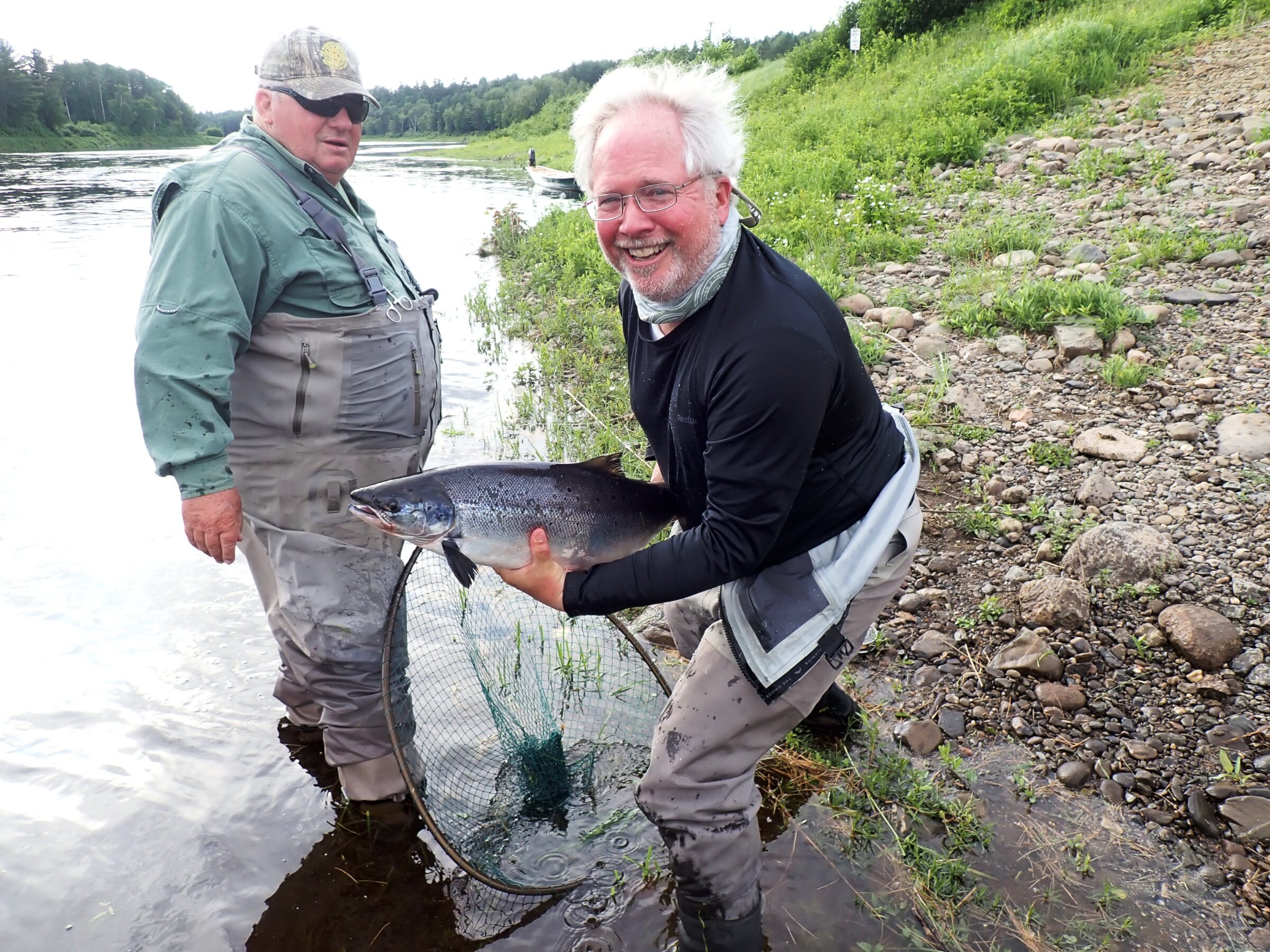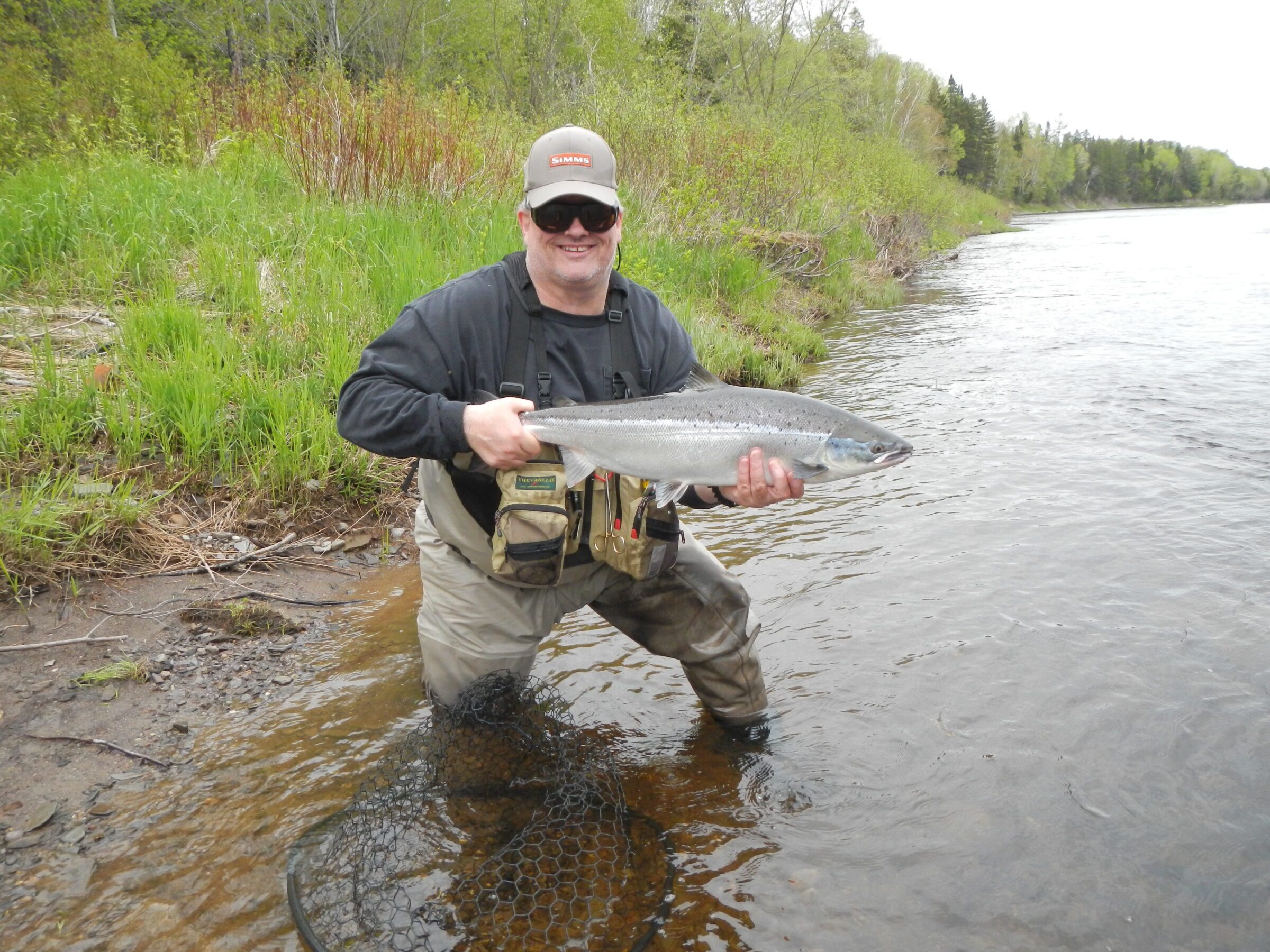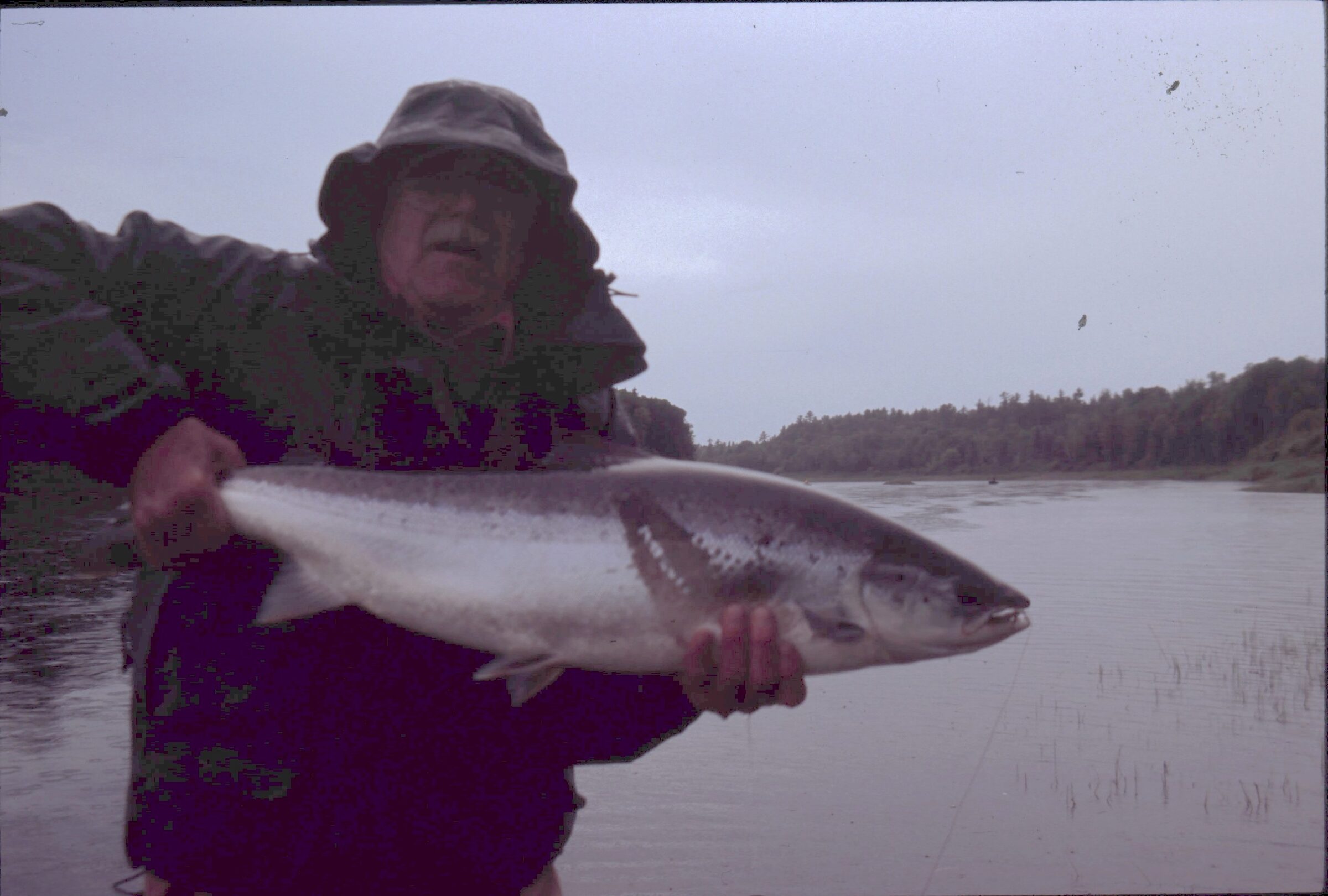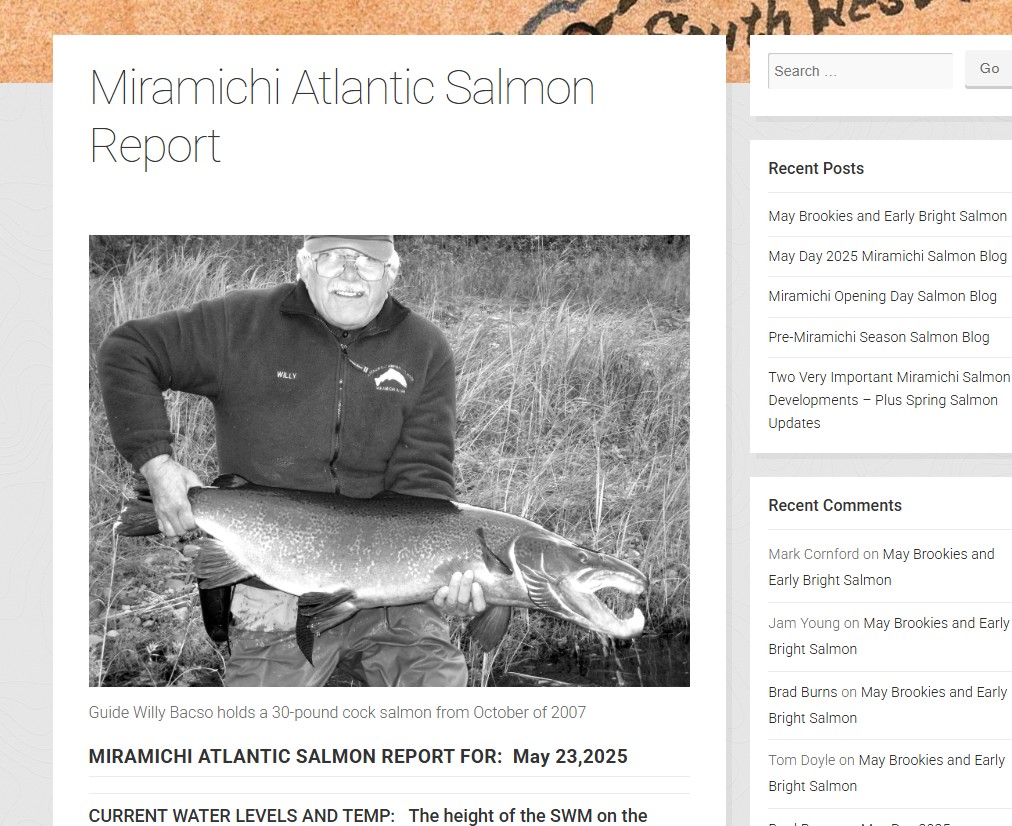
Miramichi Bright Salmon Season Begins Amidst More DFO Treachery

It’s about that time of year again! Darrell Warren and Andy Dumaine with the June salmon that Darrell has just netted for him.
Fishing Friends – the Moncton office of the Department of Fisheries and Oceans “DFO” has achieved a new milestone in its mismanagement of Miramichi salmon.
As one of my friends says, “All DFO has to do is slow walk the striped bass/Atlantic salmon thing and the salmon lose.” Of course he is right, but why would anyone at DFO do that? After all, Atlantic salmon and lumber have been the backbone of the Miramichi valley since the first white settlers landed here, to say nothing of the cultural importance of salmon to First Nations communities. The Miramichi has really been the unrivaled capital of salmon fishing in North America since at least the 1940s. Even today, when I pull up to either side of the border crossing at Woodstock the first words out of the agent’s mouth are usually to inquire if I’m going fishing or how the fishing was. And they are talking about salmon fishing. Even today, in the Miramichi’s reduced circumstances, lots and lots of people head to the Miramichi and its tributaries to try their luck for the King of Fish.
That the value of Atlantic salmon to so many people is not recognized by some of the folks at DFO won’t surprise those really in the know about the Miramichi. I’ve been watching DFO’s atttitude deteriorate for years. When I started going to the Boston Miramichi Salmon Association “MSA” dinners 22 years ago there was often some official from DFO in attendance, and we would sometimes get a few upbeat words about their commitment to salmon on the river. The DFO had a stake in the MSA, especially after they fobbed off the hatchery in South Esk to the MSA in 1997. DFO had founded the hatchery in 1873 and for 124 years they enhanced the runs of the world-famous fishery with hatchery output. There are those who stick their noses up at hatcheries, but the scientists I know say it was the hatchery that helped the Miramichi salmon stocks stand up to the river’s immense popularity as a fishery.
I know that when I came to the Miramichi in 2002 I had done some salmon fishing here and there, and the fish of the Miramichi were every bit the equal of what I had found and have since found elsewhere including Russia, Scotland, Iceland and Labrador. The difference, though, was that on the Miramichi there were lots more of them. Other famous Canadian rivers might have runs 5 or 10,000 salmon, but the Miramichi had several productive branches, and it had 60 to 80K and was still recovering from years of netting abuse. These weren’t predominately grilse either. We saw and caught 20 pounders, and routinely came across fish that were four feet long. The angling world was noticing how good things were on the Miramichi, and it was difficult to book a prime time rod at any of the outfitters or clubs on the river.
Things were going along great in the early 2000s, culminating in 2011 when Black Brook and Rocky Brook both caught over 1,000 salmon and my own lightly fished Campbell’s pool had just under 200. Public water up and down the river was regularly fished by good numbers of anglers, and the fly shops were doing an excellent business. It was not only a good thing, but it was growing.
I’m going to come right out and say it. A handful of people at DFO who definitely aren’t willing to identify themselves, have apparently decided that the Miramichi is better utilized as a spawning ground for striped bass than it is as a river with the diverse species that have called it home since the last ice age. Yes, I’m bellyaching about salmon, but I’m also a fan of smelts, and the bass have eaten them all up. Also, the Miramichi’s once numerous, large, sea-run brook trout are now found in the headwaters of the Cains only in the tiniest of numbers since the bass explosion. All this is bad. Local people loved to eat the smelts, and the commercial fishery for them has completely collapsed. The reconditioning salmon kelts depend on the smelts too. Anecdotally the bass are also having a negative effect on lobsters. I’ve been told by several people that the bass follow the lobster fishermen around and eat the undersized lobsters being thrown back by the fishermen.
Of course, the biggest problem for the salmon is that the hordes of bass gathered to spawn in the mouths of both branches of the Miramichi are eating almost all – yes 90% or more – of the salmon smolts on their way to sea. Bass have always been a source of some mortality on the salmon, but in the early 2000s in-river smolt mortality was only about 35%. The excessive mortality from striped bass predation has caused the numbers of returning adult salmon to decline by about 90% – from 80K to 5K – in the last 14 years. It’s outrageous. Clearly the individuals who have been guilty of perpetuating this travesty should be fired from government service for life. I’d like to see them criminally prosecuted because I don’t think these are innocent mistakes, but realistically that isn’t going to happen.
So where are we now, has anything changed? No, or at least not materially. The last DFO Minister did – over the grumblings of Moncton DFO – increase this year’s bass quota to 175,000 spawning age individuals. As several scientists have pointed out it probably isn’t enough. There are likely somewhere between 350,000 and 600,000 adult spawning striped bass in the Miramichi population. The counts just aren’t accurate enough to pinpoint it better than that. While it may be unknown exactly how many new spawning age bass are entering the spawning stock biomass every year, the DFO scientists using an estimating tool called the Beaverton-Holt model should have a very good idea. It is highly unlikely that the 175,000-harvest number was derived from thin air, or that it would be calculated to have a material effect on the bass spawning stock.
One of the top predators of young of the year striped bass are or were smelts, but DFO has done what they can to destroy that population too. If DFO were serious about rebuilding the salmon population, they would allow a regular commercial harvest of stripers by the trap nets in Miramichi Bay and stay on top of the results. As retired DFO scientist John Ritter pointed out, there is no danger in reducing the population of spawning age stripers to the 100,000 necessary to co-exist with Atlantic salmon. This is borne out by how rapidly the bass population went from 5,000 to 500,000, and how many years over the last 125 or so prior to 2011 that the bass population has been below 50,000 – clearly with no harm to the bass.
In the new DFO Salmon Management Plan, Principle Number 3 pledges transparency. Honestly, this is just b.s.! You try and get any real information out of DFO. That place is a fortress. There are almost no names, no e-mails and no phone numbers other than one public information number answered by voicemail. All communications take days and the replies are all in code… or might as well be.
What has DFO done to ensure that the 175,000 bass will be caught this year? I believe that the answer is nothing. I heard an Eel Ground First Nations representative say that DFO had refused their request to increase their share of the quota from 50K to100K. The FN person said that the other bands are not prepared for this fishery and have never had any interest or expertise in it. DFO has said in the past that the fish traps that used to provide the now First Nations only fishery cannot be used as subcontractors to catch these fish. Of course not, that would solve all these problems. Go ahead and contact DFO and see if you can find out if that has changed. I hope so, but I doubt it.
Don’t put your faith in the smolt-shepherding experiments going on either. First, some scientists believe that the smolts imprint as they drop down the estuary, and so smolts that are trapped upstream and taken around the bass to salt water may not return to their native spawning areas. It will be several years – that we don’t have – to know the full answer to that question. Beyond that, the Miramichi should be sending about 2,000,000 smolts a year to sea over the course of about two weeks every May. The logistics of netting and moving any measurable portion of those smolts around the bass every year, regardless of water conditions is simply a non-starter. It’s an interesting experiment, but no more than that.
We can’t stock our way out of this. The popular expression is that more smolts are simply more food for the bass. When the bass are getting anything like 90% of the smolt run that is true. We must get the bass numbers back to under 100,000, but stocking is still crucial to a timely recovery. The salmon have been beaten down to a critically low level, and part of the smolts survival strategy in the ocean is to travel in large groups. A hatchery committee of internationally recognized experts donating their time to the MSA has suggested some serious hatchery upgrades which are being done. They have also devised a stocking strategy that grows wild smolts in the hatchery. At the one year point the smolts will be sexed by ultrasound and most of the male smolts released as super smolts. Hopefully their increased size and maturity will get more of them by the bass. Some male smolts and the females will remain in the hatchery where new lighting, temperature and feeding techniques will cause many of them to be large, mature grilse in the fall of that same year. These fish will be released to spawn naturally. Those that aren’t mature then will be kept an additional year and released to spawn naturally as multi-sea-winter fish. Wild, precocious parr will provide a great deal of the male spawning component – as they do now.
This plan, endorsed by the First Nations was presented to DFO in March along with a request to collect 4,500 smolts, 2,500 from the SWM and 2,000 from the NWM. The plan was flatly rejected by DFO who said they needed more time to study the program. They asked the MSA and FN to resubmit the proposal with all the fish to be used as super smolts with the idea that this would give DFO another year to think about things. That was immediately done. The smolt wheels were already at the ready since they were being used for the other tagging experiments that determine how many smolts the bass are eating. MSA and FN have been calling almost daily to get permission to start collection, but they have been refused. DFO in their supposed new-found transparency just says that they are still considering it and that they are aware of the time constraints. But guess what, the time is up! The height of the smolt run was last week. We are down to dribs and drabs for smolt catches, and if we got permission today there is no way that we would gather enough smolts for the stocking plan. “All DFO has to do is slow walk the striped bass/Atlantic salmon thing and the salmon lose.” The blame goes directly on to DFO Moncton that the Miramichi salmon have lost a valuable year of time in the battle to positively turn around the Miramichi salmon decline. And what takes away even more from any possible rationale for DFO Moncton refusing the permit to hatchery rear wild smolts for stocking as adults in the Miramichi, is the fact that the Maritimes office of the DFO in Halifax is already doing just that at the Mactaquac Biodiversity Facility in Fredericton, NB. DFO calls the program captive adult rearing. According to reports good numbers of smolts were found in the Saint John/Tobique system during both 2024 and 2025. These smolts are attributed to the natural spawning activity of adult salmon released in the wild to spawn after being raised in this facility. It is completely verifiable from within DFO’s own experience that captive rearing can produce viable adult spawners.
What was DFO risking by approving this plan? Of those 4,500 smolts, only about 450 will make it by the bass. Given 5% ocean survival about 22 of these smolts will survive to return as adults, and of those just 11 would be females. In the hatchery we can hope for 85% survival of the 2,250 females or about 1,912 females reaching the spawning grounds. Those 1,912 may not be completely as effective as 1,912 wild fish, but they will be a lot more effective than just 22. Actually, I understand that results in the Fundy Park program – which is very similar just using ocean pens instead of hatchery tanks – is now experiencing a very similar egg hatching percentage to wild fish. So, what is DFO Moncton doing? They have been watching the world famous Miramichi salmon fishery slip away due to their disregard of DFO policy which specifically prohibits them from managing any predator species so that it does serious harm to a prey species. DFO should have already weighed every option and should have sat down with the MSA and FN long ago to work out a hatchery plan to try and help turn the salmon population around. If they have concerns, they should be out in the open and they should be eager to help find solutions that they can agree on. This is transparency. At the very least DFO representatives are guilty of obstructing the salmon’s recovery in the Miramichi, and at the worst – and I feel the most likely – some individuals there are actually plotting the salmon’s continued decline in favor of promoting the Miramichi as a bass fishery. We can’t just stand by and let it happen.
Right now the political chairs are moving around in Ottawa, but there will be a new house fisheries oversight committee after May 26th and I plan to start a new letter writing campaign at that time. Save Miramichi Salmon’s lawsuit is still in progress too, and we will soon be facing our first test as DFO tries to get our efforts dismissed in court. Keep your fingers crossed. If DFO loses this motion we may see some real changes in their attitude as they face the prospect of their treachery being thoroughly publicly aired in court.

Allen Dobson with this terrifically shaped NW Miramichi springer from May 22, 2013. No amount of striped bass could replace this fish for most of us.
Despite all the bad news that I have just mentioned, it is the last week in May, and an angler can now go out onto either branch of the Miramichi and have a reasonable chance of catching a bright salmon. Those odds will also get a bit better every day. Here are a couple of photos from my files of some of those bright May salmon. Don’t forget, if you do land an early fish, it may win you the MSA certificate for the first bright salmon of the season. There are photos and the e-mail address to report your catch in my last blog on brook trout.

Tyler Coughlan with another early fish caught by my friend Jim Graul at Campbell’s a couple of years back.
Also in my last blog was a picture of a zonker fly that did well on the Cains Brookies. This fly, according to Bill Utley who tied the one I fished, is called the Silver Ghost. Here is a link to famous UK fly tyer Davy McPhail tying the fly. It is as easy to tie as it is effective. Bill is a follower of McPhail, and thought this fly made a great smelt imitation.
I’m going to wind up this blog by giving you a link to a good article that you may or may not have seen by Roger Jenkins of Storeytown. Roger is bemoaning the decline of Miramichi salmon and complaining about the politicians who have let DFO get away with its nefarious deeds. If you haven’t seen it, it is well worth reading.
Don’t forget to check out my daily Salmon Report on my website. It hasn’t been daily yet, but it is regular and will get more regular as we get into some salmon. I’ll be moving up to the Miramichi on the 13th, and after that it will be first-hand observations every day. Here is a link to the report. Also, if you heard about this blog from a friend, you can subscribe to get notices of new blog entries at no charge and with no risk to our privacy by clicking the report link and then the Brad Burns Fly Fishing logo on the top to home page. From there just scroll down the home page and sign up at the bottom.
Thanks for reading. Brad Burns

Willy Bacso looks like a hooded, mid-evil priest with this incredible June salmon from 20-plus years ago. Sigh…




Hi Brad, Very sad situation. But we are going to BB 3X. Sandy and I and my daughter on June 28th. Couples in early Sept and back in the 2nd week of Oct with Sandy, daughter and other friends. Low expectations but still wonderful to be there.
Indeed it is. I’ll be there all three of those weeks also. Tight lines!
Need the natives, to take matters into their own hand. Take all the stripers they can catch. They should also do a protest in a DFO parking lot in Fredericton, where non natives can join them.
It would be fine with me, though it should be in Moncton. 😑
I guess alot of flyfishers are going to have to take up golf and use their camps as olf folks homes . DFO is not going to budge .
The darkest hour is just before dawn. For the last 20 years everyone has tried bending over backwards for DFO. It is time to reveal Moncton’s malfeasance to their superiors, the politicians and the courts.